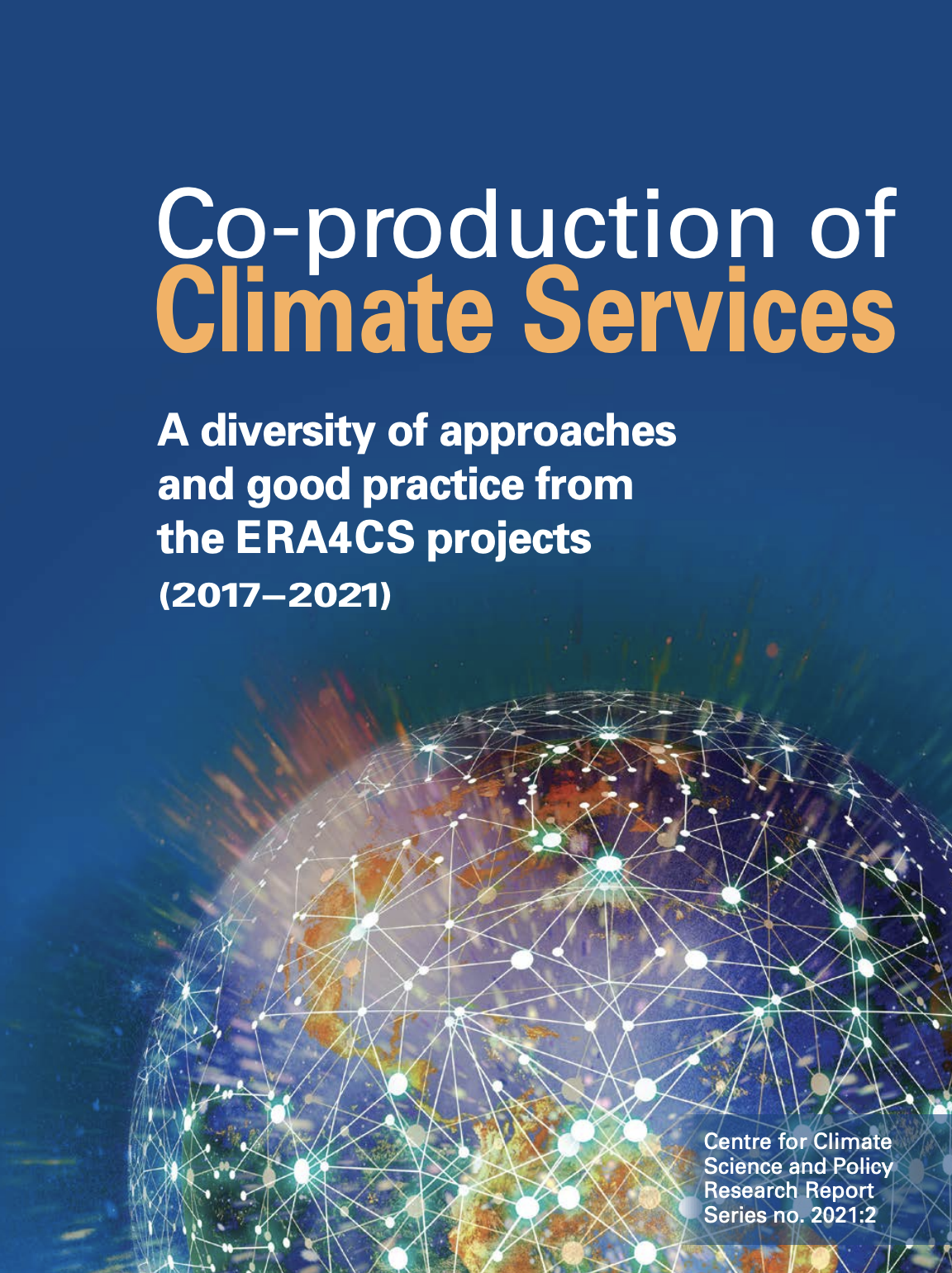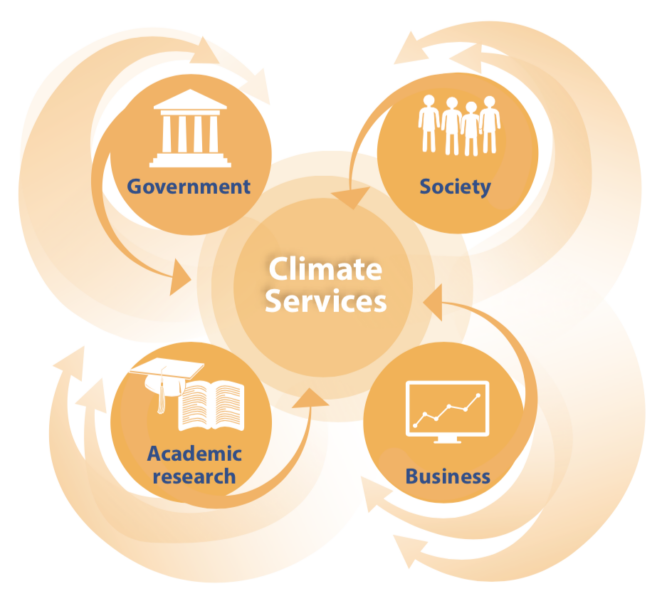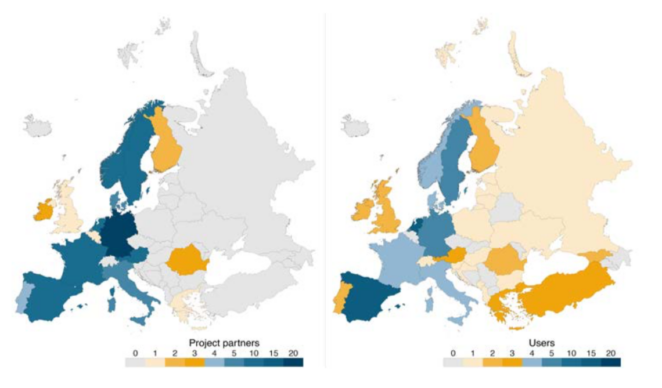Co-production of Climate Services – A Diversity of Approaches and Good Practices from the ERA4CS Projects (2017-2021)

Introduction
Co-production of knowledge is a key element in the development of useful, usable and used climate services. While it is possible to develop climate services without the involvement of end-users, climate service co-production has significant advantages for usability, and substantially affects the ability of the private and public sector to use climate change data and information to support adaptation.
The ERA-NET Consortium “European Research Area for Climate Services”, (ERA4CS) projects was designed to boost the development of efficient Climate Services in Europe. Calls for proposals to ERA4CS were opened in 2016, under the title “Researching and Advancing Climate Services Development’’. A total of 26 projects received funding as a result, to support the development of better tools, methods and standards on how to produce, transfer, communicate and use reliable climate information to cope with current and future climate variability, particularly in Europe.
This report is a value-added activity of 16 of the projects in the ERA4CS Programme to understand the practices of the projects with regard to co-producing climate services together with users and developing pathways, methods and approaches to make climate services more useful, usable and used. The projects offer an ideal opportunity to learn about current approaches and methods that research teams in different geographic contexts, sectors and with varying degrees of transdisciplinarity use to strengthen the practice of co-production. The lessons-learned offer a valuable source of experiential learning that could be of benefit for future projects, and the conversion of research funding into societal impact.
This weADAPT article is an abridged version of the original text, which can be downloaded from the right-hand column. Please access the original text for more detail, research purposes, full references, or to quote text.
Co-production of climate services
The term “co-production of climate services” is used to refer to the process of collaboration between science and society at large, in order to develop climate services and products that enable climate action. It comprises all elements of the knowledge production process, including co-designing the research outline and methodological approach, the service co-development and co-production principles and process and principles.
Co-production is key for the uptake and inclusion of climate services in decision-making processes by increasing the usability of climate data and information. As such, it aims at dissolving the boundaries between the classical disciplinary development of climate services, driven purely by the quantity and quality of climate data.
Through a participatory transdisciplinary design approach involving the users, we reach a co-construction of a shared representation of reality and needs. The users must be included, encouraged to contribute and be empowered from the inception of the project planning and development process. This process requires the combination of scientific data and information with knowledge from different formal and informal sources to generate climate services.
The sources of formal knowledge production are explained by the quadruple helix of innovation (see below) under which four major actors are needed in the innovation system of co-production: science, policy, industry and society. Most of the ERA4CS projects have included a diversity of combination of these four major actors when developing their climate services.

Mapping the diversity of co-production of climate services
Scales and sectors
ERA4CS projects that were surveyed developed climate services primarily for European countries, with case studies in Western Europe being more prevalent. There were some projects with case studies in the Mediterranean, Central-Eastern Europe (i.e., Austria and Romania), as well as case studies in North and West Africa, the Caribbean and Asia.

In addition to the spatial scale, the various projects utilised (and in some cases generated) climate data as well as produced climate services representing different temporal scales (from early warning, to observation and weather forecast, seasonal forecast and climate projections).
The majority of projects surveyed simultaneously engaged stakeholders in multiple sectors. Multi-sector projects that focussed on the Water-Energy- Agriculture Nexus develop services for sectors including hydropower, food production, wind and solar energy, and water management. A small number of projects (n=4) focused on creating services for other sectors such as tourism, health, disaster risk management, fisheries, aviation and the marine sector.
Stakeholder identification
The survey identified between users (those that will directly engage with and use the climate services) and stakeholders (those that may indirectly benefit, interested or involved in the climate service). However, the responses demonstrated that there was generally limited distinction between these two categories in the ERA4CS projects.
Interview respondents recognised the importance of involving pre-established contacts and networks. A common view amongst interviewees was that pre-existing relationships based on trust and reliability are key for successful stakeholder engagements.
Modes of engagement in the co-production process
The role of project or research team can be categorised along a continuum that passes through three main axes throughout the project lifecycle:
- Advisory: the team provided advice and information to assist the development of climate services.
- Production: the team was responsible for the development of the complete climate service. This implies that the science team took the lead role in development and engagement.
- Knowledge broker: the team facilitated the conversion of climate change data to information and finally to knowledge production but did not create the climate services.
Half the projects surveyed indicated that the research teams had a combination of roles. In six of the projects the research teams had both a production role and a knowledge broker role and at least two projects functioning in all three; advisory, production as well as knowledge broker role.
Analysis of co-production
Three aspects of co-production employed in ERA4CS projects were analysed:
- Processes/tool or mechanism of engagement used;
- Possible changes experimented on the engagement mechanisms throughout the project to improve the engagement in the process;
- Metrics used to evaluate the success of this process
Good practise in climate service co-production
Forms of Engagement
The forms of engagement applied in ERA4CS projects were varied and often used in different combinations, depending on the case study and thematic context. These included informing stakeholders and users, through public and invited talks, presentations, training courses, and seminars with other students and other users. Questionnaires and surveys were regularly used to determine the needs of stakeholders and users and evaluate climate services and products. Engagement also involved participatory exercises such as workshops, where researchers, stakeholders, and users met to mutually influence perspectives.
Entry Points for Engagement
The timing of initiation of engagement is important in terms of the quality and extent of interactions and the resulting outputs or products. The focus and direction of climate service development are often determined at the beginning of projects. Early engagement allowed discussions about the topics and questions of a project together with stakeholders and users. Results from the interviews indicated that the science-society relationship at the onset of the project had major implications for the cost, process and methodology for co-development.
Intensity of Engagement
ERA4CS projects demonstrated that developing climate services in highly technical and/or highly regulated domains almost mandates a high intensity of involvement. This is necessary to ensure the relevance and credibility of the climate service, which should be as specific and as accurate as the domain they aim to cater for. Several projects reported challenges with attracting the interest of relevant users in developing a climate service, particularly when attempting to attract new users. When stakeholders were engaged, projects also experienced challenges in keeping these stakeholders committed throughout the entire process, and high turnover of users were common.
Recommendations for providers, users and funders of climate services
Recommendations for researchers
- Combine bottom-up and top-down perspectives to initiate co-design process – this can support effective co-design. The facilitation of workshops with user boards that are guided by science-driven issues identified during the preliminary stage of the project can provide a solid starting point for the co-design process.
- Promote inclusivity by paying attention to the diverse needs of users
- Address the inequalities framing climate change and promote inclusivity through intersectionality and capacity building. Include multiple types of users, organise training events for users to clarify current limits of science, and establish a common language and shared concepts. Integrate the work of researchers from STEM and Social Sciences & Humanities subjects to carry out interdisciplinary co-design.
Recommendations for users
- Keep in mind the distinction between final users and intermediate consultants – what kind of user are you?
- Pre-assess your needs – what is my need analysis?
- Which knowledge do you already have and how can this be complemented?
- Analyse capabilities to use climate services – what additional skills do you need?
Recommendations for funders
- Pre-assess user engagement and needs
- Ensure that projects include continuous Monitoring and Evaluation
- Based on previous tasks, include corrective measures where necessary – allows flexibility and adaptation due to changes in users’ needs
- Ensure accessibility and fairness in the co-production process
- Facilitate Interdisciplinary and focus on communication research
Suggested citation:
Máñez Costa, M.; Oen, A.M.P.; Neset, T.-S.; Celliers, L.; Suhari, M; Huang-Lachmann, J-T.; Pimentel, R.; Blair, B.; Jeuring, J.; Rodriguez-Camino, E.; Photiadou, C.; Jerez Columbié, Y.; Gao, C.;Tudose, N.-C.; Cheval, S., Votsis, A.; West, J.; Lee, K.; Shaffrey, L.C.; Auer, C.; Hoff, H.; Menke, I.; Walton, P.; Schuck-Zöller, S. (2021). Co-production of Climate Services. CSPR Report No 2021:2, Centre for Climate Science and Policy Research, Norrköping, Sweden.
Related articles:
- Tandem: online guidance for the co-design of climate services
- The Tandem framework: a holistic approach to co-designing climate services
- Co-producing climate knowledge – Great in theory, but how about practice?
- Designing Knowledge Coproduction for Climate and Development
- Transdisciplinarity, co-production, and co-exploration: integrating knowledge across science, policy and practice in FRACTAL
- What makes a good climate service? Learning from practice
- The SEI Initiative on Climate Services
(0) Comments
There is no content